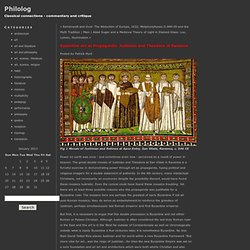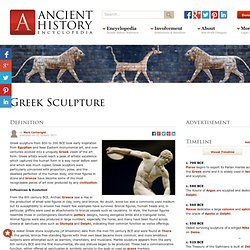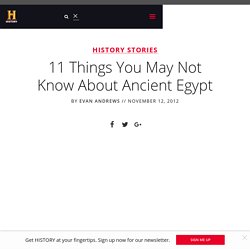

Gothic Architecture. Philolog: Byzantine Art as Propaganda: Justinian and Theodora at Ravenna. But first, it is necessary to argue that this double procession is Byzantine and not either Roman or Palaeo-Christian.

Although Justinian is often considered the last truly Roman ruler in the East and this art is in the West far outside of Constantinople as well as chronologically outside what is easily Byzantine a few centuries later, it is nonetheless Byzantine. Justifications for the propagandizing elements in these mosaics are not difficult, particularly if one is Christian emperor, however that word Christian was understood at the time given abundant heresies and a politically-charged orthodoxy that often depended on more subtle factors like a ruler's belief rather than a mere majority of members purportedly led by the Holy Spirit. Fig. 2 Justinian mosaic detail The octagonal Church of San Vitale was apparently paid for by the banker Julianus Argentarius. Fig. 3 Platoon of Six Soldiers Holding Chi-Rho Shield Fig. 4 San Vitale view, apse nearest viewer Fig. 5 Officials: Belisarius?
History of Art - contents - From Paleolithic Age to Contemporary Art. Index of /~cboening/maps/Western Civ. Medieval Civilization: Lecture Notes. Lecture Notes The Legacy of the Roman Empire and the Middle Ages in the West (ca AD 500-1450/1500) The World in Transition, AD 395-1500 Introduction The Three Heirs to the Roman Empire: 6th-7th centuries: a new period in the history of world civilization; clear that no one empire would rule the Mediterranean world; by the 7th century, three successor civilizations, the Byzantine, the Islamic, and the western European, had developed, each with its own culture, its own religion, and its own language; these three civilizations quickly became rivals.

The Byzantine Empire and the Mediterranean World at the Death of Justinian I. Islamic civilization: (7th century-ca. 1500) founded by the prophet Muhammad; language was Arabic; government and culture permeated with this dynamic new religion; it created an Empire in the old Near East, along the African coasts of the Mediterranean, & it spread into the Indian subcontinent.
Worldwide Guide to Women in Leadership. Labours of the Month, Zodiac Signs, Cardinal & Christian Sins & Virtues in Medieval Churches. Adrian Fletcher travels Renaissance & Medieval Italy, France, Spain and Britain 1,000 pages packed with Outstanding Photos, Stories, Books, Insights, Food, Restaurants and Travel Tips. World History : HyperHistory. Rome: Ancient Supercity Infographic — History.com Interactive Games, Maps and Timelines. GLAADH home page. Russian Art. UbuWeb. Art History PowerPoint Shows. The Art Story: Minimalism Movement. Minimalism emerged in New York in the early 1960s among artists who were self-consciously renouncing recent art they thought had become stale and academic.

A wave of new influences and rediscovered styles led younger artists to question conventional boundaries between various media. The new art favored the cool over the "dramatic": their sculptures were frequently fabricated from industrial materials and emphasized anonymity over the expressive excess of Abstract Expressionism. Constructing Space. Greek Sculpture. Greek sculpture from 800 to 300 BCE took early inspiration from Egyptian and Near Eastern monumental art, and over centuries evolved into a uniquely Greek vision of the art form.

Greek artists would reach a peak of artistic excellence which captured the human form in a way never before seen and which was much copied. Greek sculptors were particularly concerned with proportion, poise, and the idealised perfection of the human body, and their figures in stone and bronze have become some of the most recognisable pieces of art ever produced by any civilization. Influences & Evolution From the 8th century BCE, Archaic Greece saw a rise in the production of small solid figures in clay, ivory, and bronze. No doubt, wood too was a commonly used medium but its susceptibility to erosion has meant few examples have survived.
The oldest Greek stone sculptures (of limestone) date from the mid-7th century BCE and were found at Thera. Materials & Methods Sculptors. Mankind The Story of All of Us — History of Pyramids — History.com Interactive Games, Maps and Timelines. 11 Things You May Not Know About Ancient Egypt — HISTORY Lists. Ancient Egypt stood as one of the world’s most advanced civilizations for nearly 3,000 years and created a culture so rich that it has spawned its own field of study.

But while Egyptian art, architecture and burial methods have become enduring objects of fascination, there is still a lot you probably don’t know about these famed builders of the pyramids. From the earliest recorded peace treaty to ancient board games, find out 11 surprising facts about the Gift of the Nile. Along with King Tut, perhaps no figure is more famously associated with ancient Egypt than Cleopatra VII. But while she was born in Alexandria, Cleopatra was actually part of a long line of Greek Macedonians originally descended from Ptolemy I, one of Alexander the Great’s most trusted lieutenants.
The Ptolemaic Dynasty ruled Egypt from 323 to 30 B.C., and most of its leaders remained largely Greek in their culture and sensibilities. Vanity is as old as civilization, and the ancient Egyptians were no exception.